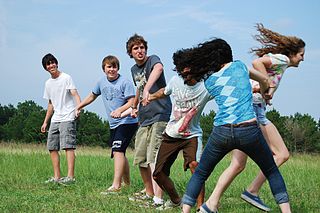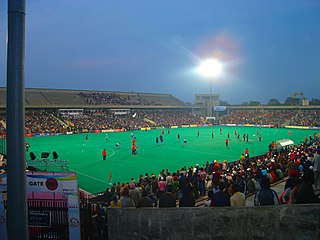Related Research Articles

Tag is a playground game involving one or more players chasing other players in an attempt to "tag" and mark them out of play, usually by touching with a hand. There are many variations; most forms have no teams, scores, or equipment. Usually, when a person is tagged, the tagger says, "Tag, you're 'It'!" The last one tagged during tag is "It" for the next round. The game is known by other names in various parts of the world, including "running and catching" in India and "catch and cook" in the Middle East.

Kick the can, is an outdoor children's game related to tag, hide and seek, and capture the flag, played with as few as three to as many as several dozen players. The game is one of skill, strategy, stealth, and stamina.

Tetherball is a game where two players use their hands to strike a volleyball which is suspended from a stationary metal pole by a rope or tether. The two players stand on opposite sides of the pole, and each tries to hit the ball one way; one clockwise, and one counterclockwise. The game ends when one player manages to wind the ball all the way around the pole so that it is stopped by the rope. It must not bounce.

Kickball is a team sport and league game, similar to baseball. Like baseball, it is a safe haven game in which one team tries to score by having its players return a ball from home base to the field and then circle the bases. Meanwhile, the other team tries to stop them by tagging them "out" with the ball before they can return to the home base. However, instead of hitting a small, hard ball with a bat, players kick an inflated rubber ball; this makes it more accessible to young children. As in baseball, teams alternate half-innings. The team with the most runs after a predefined number of innings wins.

Red Rover is a team game played primarily by children on playgrounds, requiring 10+ players.
Spud is a dodgeball variant for children and adults, where players try to eliminate each other by catching and throwing an inflated and generally soft ball. It is related to "call ball" and "ball tag".
Butts Up or Wall Ball is a North American elementary school children's playground game originating in the 1950s or earlier.. It is slightly similar to the game Screen Ball, and began in the 1940s or 1950s as a penalty phase of various city street games. Butts Up is played with a ball on a paved surface against a wall, with a variable number of participants—usually more than three and often likely to exceed ten. Butts Up tends to be played during recess, before or after school.. Popular in New England is another frequent variation of wallball that usually differs a lot from the more widely known 'Butts Up'.

British Bulldog is a tag-based playground and sporting game, commonly played in schoolyards and on athletic fields in the UK, Canada, South Africa, Australia, and related Commonwealth countries, as well as in the U.S. and Ireland. The object of the game is for one player to attempt to intercept other players who are obliged to run from one designated area to another. British Bulldog is characterised by its physicality and is often regarded as violent, leading it to be banned from many schools due to injuries to the participants.

Forty Forty is a children's game combining elements of the games "It" and Hide and seek. One player is "on", or "It", and they must capture the other players by 'spying' them rather than by tagging.
Keep Away, also called Monkey in the Middle, Piggy in the Middle, Pickle in a Dish, or Pickle in the Middle, or Monkey, is a children's game in which two or more players must pass a ball to one another, while a player in the middle attempts to intercept it. The game could be considered a reverse form of circle dodgeball, because instead of trying to hit people in the middle with the ball, players attempt to keep the ball away from them. The game is played worldwide.

"Did You Ever See a Lassie?" is a traditional folk song with a Roud Folk Song Index number of 5040.

A playground parachute is a round, multicolored, nylon sheet commonly 20 to 30 feet in diameter. It may or may not have handles on the periphery. It is used by arranging children on the outside, who then vigorously wave the parachute up and down. Playground parachutes are commonly used in kindergarten and early elementary school physical education classes, gymnastics classes, and organized recess, but is aimed for people of all ages.
Traditional Filipino games or indigenous games in the Philippines are games that have been played across multiple generations, usually using native materials or instruments. In the Philippines, due to limited resources for toys, children usually invent games without needing anything but players.There are different kinds of Philippine Traditional Games that are suited for kids, and the games also stand as one of the different culture and/or traditional games of the Philippines. These games are not only fun to play, but these games are also good for you. This is because different games require different skills. These games are also an important part in Filipino culture.

Duck, Duck, Goose is a traditional children's game often first learned in preschool or kindergarten. The game may be later adapted on the playground for early elementary students. The object of this game is to walk in a circle, tapping on each player's head until one is finally chosen; the chosen player must then chase the picker to avoid becoming the next picker.

Tumbang preso, also known as tumba lata or bato lata, is a Filipino traditional children's game. The game involves throwing a slipper at a can or bottle, which one player - the tayà - attempts to guard. The game is usually played in backyards, parks, or in streets when there is little traffic in an area.
Traditional games in Indonesia are games commonly played by Indonesian children and have roots / acculturated to the Indonesian native culture. Indonesian parents often using traditional games to educate their children about character building. As a result, nearly all children in the era before the 1990s play traditional games.

Punjabis play a wide variety of sports and games, ranging from modern games such as hockey and cricket, to the more traditional games such as Kabaddi, Kushtian (wrestling) and Khuddo khoondi. There are over 100 traditional games and sports of Punjab.

There are a variety of traditional rural games in the historical region of Bengal. These games are typically played outside with very limited resources. Many of them have similarities to other traditional South Asian games. Nowadays, with urbanization, many traditional games are being played less and less.
Pakistan has many traditional games and sports. Many of them are similar to the traditional South Asian games played in countries such as India and Bangladesh.
References
- ↑ Ralph Townsend, Ways That Are Dark , p. 12.
- ↑ Bancroft, Jessie H. (1922). Games for the Playground, Home, School and Gymnasium. Macmillan Company, New York. p. 148.
- ↑ Gidney, Francis ("Gilcraft") (1928). Gilcraft's Book of Games (PDF). London: C Arthur Pearson Ltd. p. 23.